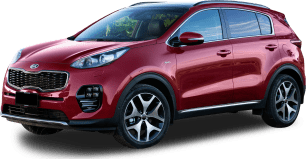The Outback price range stretches from $35,470 for a good honest diesel manual through to a flat-six auto at $48,740, with three distinct models sandwiched in between. Subaru likes to publish the drive-away price on its website, however we'll be dealing in list prices (before on-road costs) here.
The range breaks down into three petrol models and two diesels, for a total of five trim levels.
The 2.0D opens the range at $35,470 for the six-speed manual while the 2.0D Premium manual starts at $42,240. Add $3000 for the CVT automatic transmission.
Standard features on the 2.0D with manual transmission are 17-inch alloy rims, six speakers, dual-zone climate control air conditioning, reverse camera, rain sensing wipers, cruise control, daytime running lights, halogen headlights (no xenon, projector or HID headlights), a mild body kit with side skirts, power windows, cloth trim, full size spare tyre, hill holder and electric power steering.
Opt for the CVT diesel and you pick up EyeSight, which adds active cruise control and a suite of safety features as well as X-Mode which helps in the slippery stuff and includes hill descent control. This isn't an off-road review, but X-Mode is very effective on the slippery stuff.
If you're after a more premium package, the aptly-named 2.5i Premium sees the addition of Vision Assist to go with EyeSight.
Stepping up to the 2.5i yields larger 18-inch alloy wheels, standard CVT automatic transmission, leather steering wheel, rear spoiler, and it swaps out the turbo diesel for a non-turbo petrol four-cylinder. The 2.5i starts at $36,240.
If you're after a more premium package, the aptly-named 2.5i Premium sees the addition of Vision Assist to go with EyeSight, leather trim, sunroof, sat nav, powered heated front seats, a bigger touch screen at 7.0-inches, two USB ports, powered tailgate, keyless entry, push button start and LED headlights. It costs $42,240.
Finally, the 3.6R gets you the big-banger performance from the flat six and an 11-speaker stereo (including subwoofer). It costs $48,740.
The accessories range includes floor mats, boot liner and various protective parts.
Still missing across the range are Android Auto and Apple CarPlay, but you can plug in your iPhone or Android device to the sound system or pair via Bluetooth. Powered by Subaru's Starlink touchscreen software, the multimedia system comprises of a CD player and AM/FM radio (but no DAB across the range). Your multimedia needs can also be fulfilled with a USB port where you can plug in a phone or use the inbuilt MP3 player with a memory stick.
The accessories range includes floor mats, boot liner and various protective parts (underbody protection is limited to wheel-arch liners).
Missing from the standard spec lists are a DVD player, parking sensors (dealer fitted only), heated steering wheel, snorkel, bull bar, nudge bar, driving lights, seat belt extender, tonneau cover, canopy, chrome exhaust tips (they're hidden away behind the bumper), park assist, performance suspension or a high capacity spare battery.
Colours include Crystal Black, Dark Blue, Lapis Blue, Oak Brown Pearl, Tungsten (a sort of pink), Venetian Red, Dark Grey, Platinum Grey, Ice Silver and Crystal White. Sadly, the traditional green and gold combo of the original is no longer available. The vivid orange on the XV is - perhaps mercifully - also unavailable.
A regular question we get from prospective buyers is, "Where is the Subaru Outback built?". In the Australian case the Outback hails from Japan, while US buyers get theirs from Subaru's Indiana plant.











.png)










































.png)





















 copy.png)














